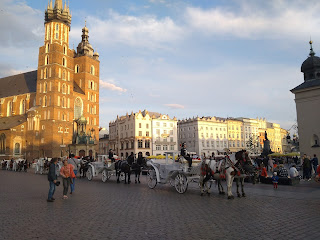 |
| Inside the church |
While Warsaw was pretty and colorful, Krakow's Old Town was like a fairy tale. An idyllic place for a wedding. When we arrived from the train station, we had to cross the enormous main plaza-- the biggest market square in Europe-- with its long Renaissance market building (Cloth Hall) in the middle. Eleven streets converge to make this square! In one corner is a brick clock tower, and in the opposite a brick church. As we traversed the plaza, we had to be careful to avoid horse-drawn carriages trotting with happy couples in tow. A few hours later, in another Krakovian church, another happy couple was tying the knot. The inside of the church was decked in gold, and during the ceremony tourists popped in to take pictures. Like paparazzi at a royal wedding! And no fairy tale wedding would be complete without the couple being whisked away in their very own horse-drawn carriage. The rest of us walked a few minutes by the riverside to get to the reception. It was held on a roof with amazing views of the Vistula River and Wawel Castle.
 |
| View of Wawel from the reception |
What's the difference between a Polish wedding and an American one anyways? Based on my extensive research--that is, attending one Polish/American wedding in Poland hehe-- there are only a few striking differences. Once gathered for the reception, there was a toast in honor of the bride and groom. The usual. Except, afterwards the couple broke their glasses on the the floor and then cleaned it up. Sounds like wedding traditions in other countries, representing working together in the years ahead. The other main difference was that after dinner they put a bottle of vodka on each table. I wasn't surprised per se. After all, it's Poland! However the extra vodka bottles seemed extravagant on top of the open bar. Nothing wrong with that! Na Zdrowie! Booze wasn't the only thing available all night long. Nowadays it seems somewhat common at weddings to have a snack bar to replace any calories lost dancing in the hours after dinner. At this wedding, in addition to that, they had two different sit-down meals after dinner, before and after midnight. One of those was my new favorite soup, zurek.
 |
| A corner of Krakow's Market Square |
 |
| Observing the university courtyard |
Despite having plenty of vodka at our disposal all night, we were able to do some sightseeing the next day. (Perhaps there's a difference between Galician and Polish weddings. We the stragglers left at 3:30. In Galicia the stragglers last past dawn. Or so I've heard.) Everywhere you look, Krakow feels historic. No wonder the city is a UNESCO World Heritage Site. Vestiges of the past are spread out further than just the expansive Old Town. Even when we ventured out, seemingly far from the historic attractions, we came across a centuries-old church. In a corner of it there is a small metal grid. Unnoticeable, if not for the little sign. According to legend, it's protecting what is supposed to be the footprint of Queen Jadwiga. In the 14th century, the young queen took pity on a poor construction worker and stuck her foot in the wet cement so that he could sell the gold clasp from her shoe. Her footprint remained. This was only one of many historic sites we came across. We also stopped by a small college courtyard from one of Eastern Europe's oldest universities. Another curious visit was underneath the Cloth Hall in the main plaza. The underground museum is all about the history of Krakow and definitely worth the visit (especially since it just happened to be free the day we went). It was very interesting and interactive. Among other things, we got to compare our statures to people in the Middle Ages, as well as weigh ourselves using their units of measurement.
But the clear gem of Krakow is perched atop a hill, behind fortress gates. That's the Royal Complex of Wawel. A castle, tower, palace, gardens, cathedral, artifacts, fire-breathing dragon: Wawel's got it all! It made for a lovely afternoon going on a tour and wandering around the gardens and courtyards.
Krakow also has a lot of Jewish history. Kazimierz is the Jewish quarter right outside the Old Town, housing synagogues, Jewish cemeteries, and a lot of cool restaurants and bars. One such restaurant was called GALICIJA. We didn't go in, but appreciated the connection. Instead we opted for decked-out pizza baguettes from a stand in Kazimierz's lively flea market. Just on the other side of the river from Kazimierz are two more sites related to the wrong side of Jewish history. Unfortunately Schindler's Factory was sold out for the day, but we did get to check out The Eagle Pharmacy. This now-museum was right in the middle of the ghetto that the Nazis created. The pharmacy remains as it did in the 1940s, except now the drawers all have artifacts or information related to the ghetto and Nazi invasion.
Overall, I really enjoyed Krakow and could see myself living there, if only for a short time. There were so many things left to explore! And it has plenty of greenery, including a park that surrounds the Old Town. Plus I finally found my ideal paczek shop. Donuts everyday!
Overall, I really enjoyed Krakow and could see myself living there, if only for a short time. There were so many things left to explore! And it has plenty of greenery, including a park that surrounds the Old Town. Plus I finally found my ideal paczek shop. Donuts everyday!

